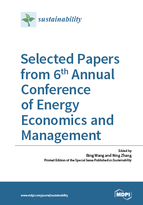Selected Papers from 6th Annual Conference of Energy Economics and Management
A special issue of Sustainability (ISSN 2071-1050).
Deadline for manuscript submissions: closed (30 January 2016) | Viewed by 103836
Special Issue Editors
Interests: sustainable development; development economics
2 Institute of Poyang Lake Eco-economics, Jiangxi University of Finance and Economics, Nanchang 330013, China
3 Faculty of Geosciences and Environmental Engineering, Southwest Jiaotong University, Chengdu 611756, China
Interests: environmental economics; energy economics
Special Issues, Collections and Topics in MDPI journals
Special Issue Information
Dear Colleagues,
This Special Issue will consist of selected papers from the “6th annual conference of Energy Economics and Management”, a large conference held in Guangzhou, China, 11–13 November 2015. The topic of this conference will be “Toward a sustainable low carbon China: New global carbon reduction agreement and Energy Policy”. This conference is co-hosted by the National Natural Science Foundation of China (NSFC), the Project Management Research Committee China, and Jinan University (Guangzhou).
This conference is one of the leading conferences in China for presenting novel and fundamental advances in energy economics and management for policy decision making. The purpose of this conference is for scientists, scholars, engineers, and graduate students from universities/research institutes to present ongoing research activities in order to exchange research ideas in the area of energy economics and management. This conference provides opportunities for delegates to exchange new working papers and application experiences, face-to-face, in order to establish research or collaboration relations. The scope of this Special Issue encompasses topics related to energy economics and management, at both the macro- and micro-levels.
Prof. Dr. Bing Wang
Prof. Dr. Ning Zhang
Guest Editors
Manuscript Submission Information
Manuscripts should be submitted online at www.mdpi.com by registering and logging in to this website. Once you are registered, click here to go to the submission form. Manuscripts can be submitted until the deadline. All submissions that pass pre-check are peer-reviewed. Accepted papers will be published continuously in the journal (as soon as accepted) and will be listed together on the special issue website. Research articles, review articles as well as short communications are invited. For planned papers, a title and short abstract (about 100 words) can be sent to the Editorial Office for announcement on this website.
Submitted manuscripts should not have been published previously, nor be under consideration for publication elsewhere (except conference proceedings papers). All manuscripts are thoroughly refereed through a single-blind peer-review process. A guide for authors and other relevant information for submission of manuscripts is available on the Instructions for Authors page. Sustainability is an international peer-reviewed open access semimonthly journal published by MDPI.
Please visit the Instructions for Authors page before submitting a manuscript. The Article Processing Charge (APC) for publication in this open access journal is 2400 CHF (Swiss Francs). Submitted papers should be well formatted and use good English. Authors may use MDPI's English editing service prior to publication or during author revisions.
Keywords
- Low carbon and sustainable development
- Climate change economics and policy
- Carbon emissions trading market and carbon finance
- Resources and sustainability management
- Energy economics and finance
- Energy security and energy poverty
- Renewable and sustainable energy
- Energy and environmental modeling






